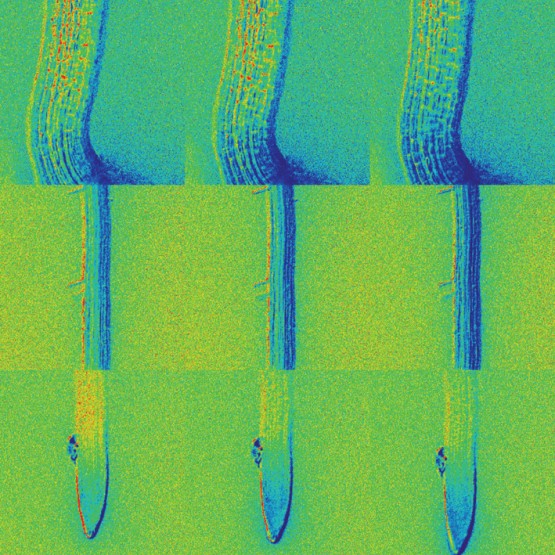Biologists Develop Nanosensors to Visualize Movements and Distribution of Plant Stress Hormone

Time sequence shows how mustard seedlings take up and distribute ABA through roots and other parts of the plant during germination. Credit: Rainer Waadt, UC San Diego
The achievement will allow researchers to conduct further studies to determine how the hormone helps plants respond to drought and other environmental stresses driven by the continuing increase in the atmosphere’s carbon dioxide, or CO2, concentration.
A paper describing their achievement appears in the April 15 issue of the scientific journal eLife and is accessible here.
The plant hormone the biologists directly tracked is abscisic acid, or ABA, which plays a major role in activating drought resistance responses of plants and in regulating plant growth under environmental stress conditions. The ABA stress hormone also controls the closing of stomata, the pores within leaves through which plants lose 95 percent of their water while taking in CO2 for growth.
Scientists already know the general role that ABA plays within plants, but by directly visualizing the hormone they can now better understand the complex interactions involving ABA when a plant is subjected to drought or other stress.
“Understanding the dynamic distribution of ABA in plants in response to environmental stimuli is of particular importance in elucidating the action of this important plant hormone,” says Julian Schroeder, a professor of biology at UC San Diego who headed the research effort. “For example, we can now investigate whether an increase in the leaf CO2 concentration that occurs every night due to respiration in leaves affects the ABA concentration in stomatal cells.”
The researchers developed what they call a “genetically-encoded reporter” in order to directly and instantaneously observe the movements of ABA within the mustard plant Arabidopsis. These reporters, called “ABAleons,” contain two differentially colored fluorescent proteins attached to an ABA-binding sensor protein. Once bound to ABA, the ABAleons change their fluorescence emission, which can be analyzed using a microscope. The researchers showed that ABA concentration changes and waves of ABA movement could be monitored in diverse tissues and individual cells over time and in response to stress.
“Using this reporter, we directly observed long distance ABA movements from the stem of a germinating seedling to the leaves and roots of the growing plant and, for the first time, we were able to determine the rate of ABA movement within the growing plant,” says Schroeder.
“Using this tool, we now can detect ABA in live plants and see how it is distributed,” says Rainer Waadt, a postdoctoral associate in Schroeder’s laboratory and the first author of the paper. “We are also able to directly see that environmental stress causes an increase in the ABA concentration in the stomatal guard cells that surround each stomatal pore. In the future, our sensors can be used to study ABA distribution in response to different stresses, including CO2 elevations, and to identify other molecules and proteins that affect the distribution of this hormone. We can also learn how fast plants respond to stresses and which tissues are important for the response.”
The study was supported by grants from the National Science Foundation and, in part, the National Institutes of Health and the U.S Department of Energy’s Division of Chemical Sciences, Geosciences, and Biosciences in the Office of Basic Energy Sciences.
Media Contact
Kim McDonald, 858-534-7572, kmcdonald@ucsd.edu
Media Contact
More Information:
http://www.ucsd.eduAll latest news from the category: Life Sciences and Chemistry
Articles and reports from the Life Sciences and chemistry area deal with applied and basic research into modern biology, chemistry and human medicine.
Valuable information can be found on a range of life sciences fields including bacteriology, biochemistry, bionics, bioinformatics, biophysics, biotechnology, genetics, geobotany, human biology, marine biology, microbiology, molecular biology, cellular biology, zoology, bioinorganic chemistry, microchemistry and environmental chemistry.
Newest articles

High-energy-density aqueous battery based on halogen multi-electron transfer
Traditional non-aqueous lithium-ion batteries have a high energy density, but their safety is compromised due to the flammable organic electrolytes they utilize. Aqueous batteries use water as the solvent for…

First-ever combined heart pump and pig kidney transplant
…gives new hope to patient with terminal illness. Surgeons at NYU Langone Health performed the first-ever combined mechanical heart pump and gene-edited pig kidney transplant surgery in a 54-year-old woman…

Biophysics: Testing how well biomarkers work
LMU researchers have developed a method to determine how reliably target proteins can be labeled using super-resolution fluorescence microscopy. Modern microscopy techniques make it possible to examine the inner workings…





















